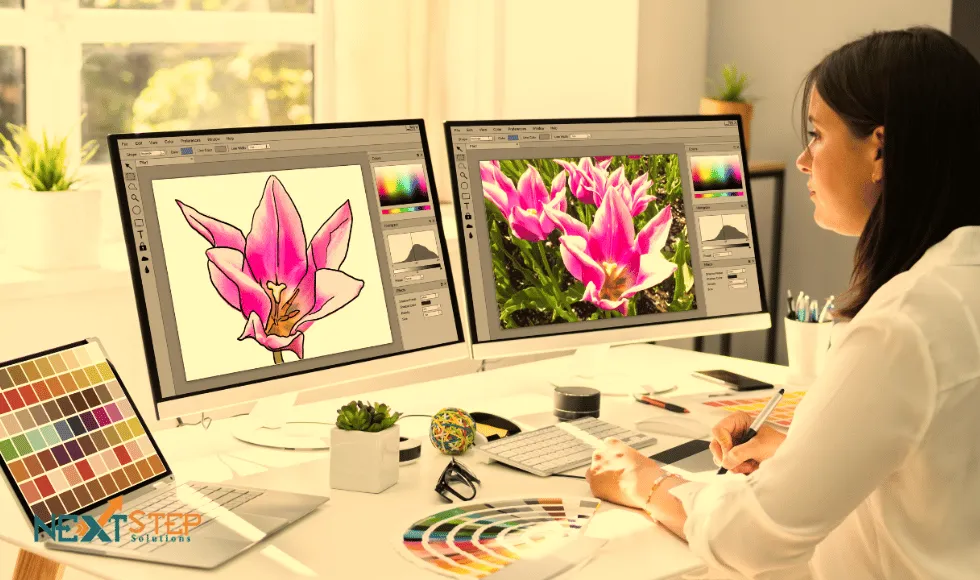Graphic design serves as the visual backbone of modern commerce, transforming abstract brand values into tangible experiences that drive consumer behavior and commercial success. Its impact extends beyond aesthetics to influence purchasing decisions, brand perception, and market positioning. Consider these critical insights:
- 94% of first impressions stem from visual elements, with users spending 6.48 seconds focused on a logo before forming brand judgments .
- Consistent design implementation elevates sales by 33% and boosts brand recognition by 80% .
- 75% of consumers assess a company’s credibility based solely on its visual identity and website design .
Core Business Functions Enabled by Graphic Design
1. Brand Differentiation & Market Positioning
Visual identity systems (logos, color palettes, typography) create immediate market distinction. Color psychology directly influences 85% of purchase decisions, with blue—associated with trust—employed by 57% of leading brands . Strategic design consistency across physical and digital touchpoints, including packaging, websites, and advertising, enables 3.3x higher revenue growth compared to visually inconsistent competitors .
2. Consumer Behavior Influence
Original graphics outperform generic stock imagery by 41% in engagement metrics . Custom illustrations, infographics, and data visualizations simplify complex information, increasing content comprehension by 78% and shareability by 52%. Furthermore, 61% of consumers act on recommendations when accompanied by compelling visuals .
3. Operational Efficiency & Cross-Functional Integration
Design systems streamline marketing workflows through reusable templates, standardized assets, and brand guidelines. Businesses implementing design automation tools report 30% faster campaign deployment and 45% reduced production costs. These systems ensure cohesive messaging across departments—from product development to customer service—eliminating redundant design expenditures .
4. Digital Experience Optimization
Mobile-responsive interfaces with intuitive navigation reduce bounce rates by 38% and increase conversion rates by 17%. Visual hierarchy principles guide users toward desired actions, with strategically placed CTAs improving click-through rates by 202% .
5. Cultural Relevance & Emotional Connection
Authentic visual storytelling fosters 23% higher customer loyalty and increases lifetime value by 31%. Brands incorporating handcrafted elements, local cultural references, or user-generated content see 68% higher social media engagement than template-driven competitors .
Professional Knowledge Base: Color Theory in Brand Strategy
Color theory merges scientific principles with psychological triggers to shape brand perception. Below are key applications:
| Color | Psychological Association | Business Application | Market Preference |
|---|---|---|---|
| Blue | Trust, Stability | Finance, Healthcare | Preferred by 40% consumers |
| Green | Growth, Sustainability | Eco-brands, Wellness | 28% purchase influence |
| Red | Urgency, Excitement | Clearance Sales, Food | 34% impulse purchase lift |
| Black | Luxury, Exclusivity | Premium Products | 52% price premium tolerance |
| Orange | Innovation, Creativity | Tech Startups | Least preferred (12%) |
Technical Execution Principles
- Digital vs. Print Rendering: RGB (screen) and CMYK (print) color models require calibrated conversion to maintain brand consistency. Pantone’s 2025 “Mocha Mousse” exemplifies trend-aligned cross-medium palettes .
- Accessibility Compliance: WCAG 2.1 standards mandate 4.5:1 contrast ratios for readability. Accessible palettes expand audience reach by 19% and reduce legal compliance risks .
- Cultural Localization: Color meanings vary globally—white signifies purity in Western markets but mourning in Eastern cultures. Multinational brands adapting palettes see 27% higher local engagement .
Quantifiable Business Impact
Graphic design’s ROI manifests across key performance indicators:
- Revenue Impact: Brands with consistent visual identities achieve 33% higher sales velocity. Social media posts with custom graphics generate 650% more engagement than text-only content .
- Operational Metrics: Design-driven companies report 30% faster product adoption and 41% reduction in customer acquisition costs .
- Brand Equity: Visually cohesive organizations command 20% higher brand recall and achieve 3.1x higher customer retention rates .
Emerging Strategic Trends (2025)
- AI-Augmented Design: Generative tools accelerate prototyping, enabling 70% faster iteration cycles while human designers focus on emotional resonance .
- Neo-Memphis Movement: Bold geometries, kinetic typography, and surreal compositions disrupt minimalist trends, increasing social shares by 48% among Gen Z audiences .
- Sustainable Visual Practices: Carbon-neutral design workflows, including optimized image compression (reducing digital energy use by 32%) and recycled material packaging, align with eco-conscious consumer values .
- Haptic Branding: Tactile design elements—embossed logos, textured substrates—create multisensory experiences that boost emotional connection by 41% in physical products .
Graphic design remains the silent ambassador of brand philosophy, converting abstract values into visual languages that transcend cultural and linguistic barriers. Its strategic implementation directly correlates with market relevance, consumer trust, and sustainable growth in an increasingly visual economy.

